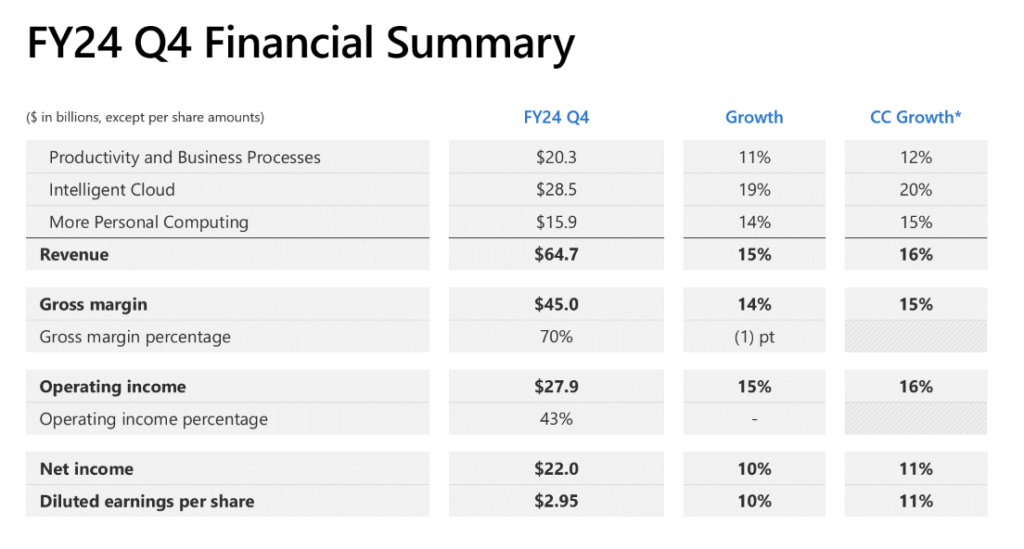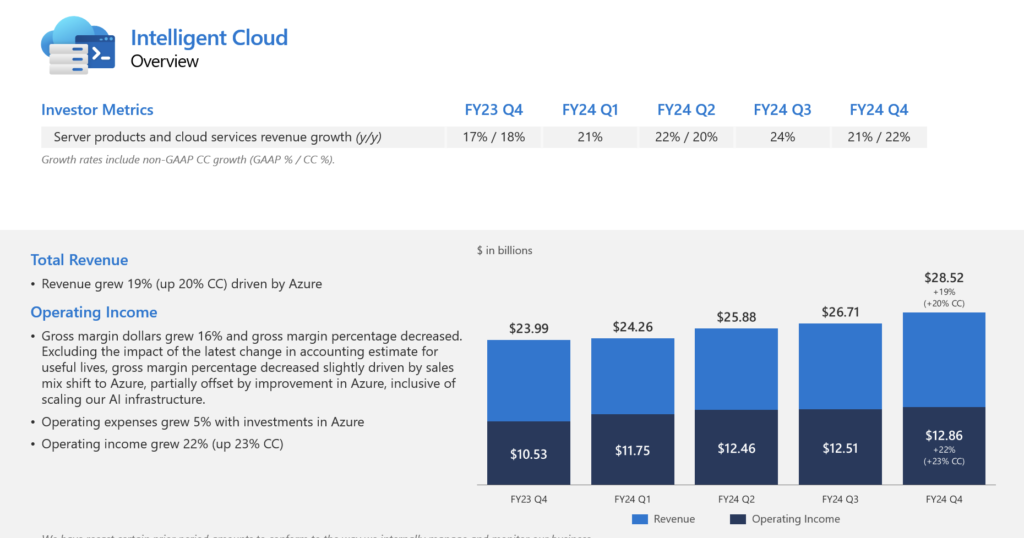Microsoft closed its fiscal year with solid financial results, reporting a total annual revenue of more than $245 billion, a 15% year-over-year increase. Microsoft Cloud (which include Azure, LInkedIn, and Office 365) revenue surpassed $135 billion, growing 23% year-over-year.
Overall Financial Performance

- Total Revenue: $64.7 billion for the quarter, up 15% year-over-year.
- Earnings Per Share (EPS): $2.95, increasing 10% year-over-year.
- Microsoft Cloud Revenue: $36.8 billion, up 21% year-over-year.
- Commercial Bookings: Increased 17% year-over-year, reflecting strong long-term commitments.
Azure’s Impact

- Revenue Growth:
- Azure and other cloud services revenue grew 29% year-over-year. The growth was driven by sustained demand for cloud services and AI-driven initiatives.
- Microsoft’s Intelligent Cloud segment, which includes Azure, reported revenue of $28.5 billion, a 19% year-over-year increase.
- AI Integration:
- Azure’s growth was significantly influenced by AI services, contributing 8 points to Azure’s overall growth. The demand for AI infrastructure remains high, and Azure has integrated new AI accelerators from AMD, NVIDIA, and its own silicon, Azure Maia.
- Azure OpenAI service, which provides access to advanced models like GPT-4, saw adoption by leading companies across various industries, contributing to Azure’s revenue growth.
- Customer Adoption and Expansion:
- The number of Azure AI customers grew by nearly 60% year-over-year, with over 60,000 customers now using Azure AI. The average spend per customer continues to rise.
- Azure Arc, aiding cloud migrations, now has 36,000 customers, up 90% year-over-year. Azure remains the hyperscale cloud of choice for SAP and Oracle workloads.
- Product Enhancements:
- Introduction of new AI and data services, such as Azure Cobalt 100 and Microsoft Fabric, which offer enhanced performance and real-time intelligence capabilities.
- Microsoft’s intelligent data platform saw a 50% increase in the number of Azure AI customers also using its data and analytics tools.
Strategic Initiatives and Investments:
- Data Center Expansion:
- Microsoft expanded its data center footprint across four continents, laying the foundation for future growth over the next decade and beyond.
- AI and Cloud Infrastructure:
- Significant investments in AI and cloud infrastructure are driving growth. Azure’s AI capabilities are being scaled to meet increasing customer demand, with plans for further expansion.
- Customer Solutions and Use Cases:
- Azure’s diverse AI and cloud services are being utilized by companies like Elastic, MongoDB, Siemens, and Snowflake. Microsoft’s AI services, such as Models as a Service, saw increased adoption, with the number of paid customers more than doubling quarter-over-quarter.
Analysis
Microsoft’s Q2 2024 earnings report shows the significant impact of Azure and AI on the company’s growth trajectory. The solid performance of Azure, driven by AI integration, strong customer adoption, and strategic infrastructure investments, shows that Microsoft is well positioned for continued revenue growth and market leadership.





